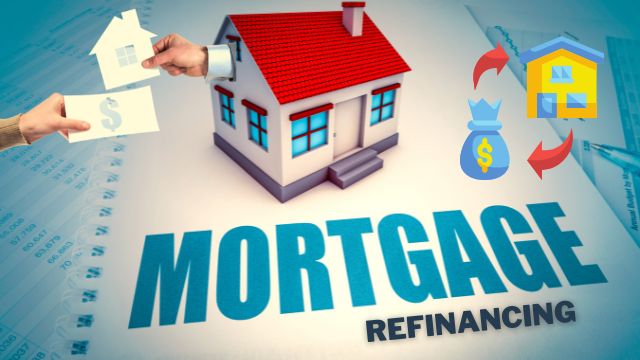You may have heard of mortgage refinancing if you’re a homeowner. Refinancing can be a great option to shorten the duration of your loan, acquire a cheaper interest rate, or cut your monthly mortgage payments. There are several things to think about, yet it might be complicated. We will walk you through all you need to know about refinancing your mortgage in our comprehensive guide to comprehending mortgage refinancing.
What is Mortgage Refinancing?
The process of paying off your current mortgage and replacing it with a new one is known as mortgage refinancing. The terms and circumstances of the new loan are usually different, such as a lower interest rate, a longer or shorter loan period, or a different kind of loan altogether. You may cut your monthly payments by refinancing, reduce your interest costs, or access the equity in your house.
Reasons to Refinance Your Mortgage
There are several reasons why homeowners choose to refinance their mortgages. Here are some of the most common reasons:
Lower interest rate
One of the most common reasons for refinancing a mortgage is to obtain a cheaper interest rate. You may cut your monthly mortgage payments and save thousands of dollars over the life of the loan by doing so.
Shorten the loan term
You can refinance to a shorter loan term if you wish to pay off your mortgage faster. This will raise your monthly payments, but you will pay less interest throughout the loan’s life.
Cash-out refinancing
Cash-out refinancing allows you to take out a new mortgage for more than you owe on your existing mortgage. You may then use the extra funds to pay down debt, make home renovations, or invest in other assets.
Convert from an adjustable-rate to a fixed-rate mortgage
If you have an adjustable-rate mortgage, you may want to refinance to a fixed-rate mortgage to lock in a low-interest rate and avoid future rate hikes.
Types of Mortgage Refinancing
There are several types of mortgage refinancing, including:
Rate-and-term refinancing
The most typical kind of refinancing is rate-and-term refinancing. It entails obtaining a brand-new mortgage with altered terms, such as a lower interest rate, a shorter loan term, or a different kind of loan. Your monthly mortgage payments should be decreased, or your loan should be paid off sooner.
Cash-out refinancing
Cash-out refinancing allows you to take out a new mortgage for more than you owe on your existing mortgage. You may then use the extra funds to pay down debt, make home renovations, or invest in other assets.
Streamline refinancing
Streamline refinancing is a simplified refinancing process that is available for certain types of loans, such as FHA and VA loans. It allows you to refinance.
The Refinancing Process
The refinancing process can vary depending on the lender, but it generally involves the following steps:
1. Evaluate your financial situation
You should assess your financial status before beginning the refinancing procedure. Calculate your credit score, debt-to-income ratio, and other indicators used by lenders to establish your loan eligibility.
2. Determine your goals
Next, determine your goals for refinancing. Do you want to lower your monthly payments, pay off your loan faster, or access your home equity? Knowing your goals will help you choose the right type of refinancing and find a lender that meets your needs.
3. Shop for lenders
Once you’ve determined your objectives, you may begin looking for loans. Compare interest rates, fees, and conditions from several lenders to discover the best offer. Before making an offer on a new property, be pre-approved for a loan.
4. Submit an application
You will need to submit an application once you’ve decided on a lender. Financial details, including your income, possessions, and obligations, as well as specifics regarding your house, must be disclosed.
5. Get your home appraised
Your lender will require an appraisal of your home to determine its value. This will help the lender determine how much to lend you and what interest rate to offer.
6. Close on your new loan
If your application is approved and your home is appraised at the desired value, you can close on your new loan. You will need to sign the loan documents and pay any closing costs or fees.
Pros and Cons of Refinancing Your Mortgage
Before you refinance your mortgage, it’s important to weigh the pros and cons. Here are some of the advantages and disadvantages of refinancing:
Pros
- Lower monthly payments: Refinancing can help you lower your monthly mortgage payments, which can free up money for other expenses.
- Lower interest rate: Refinancing can help you get a lower interest rate, which can save you thousands of dollars over the life of the loan.
- Access to home equity: Cash-out refinancing allows you to tap into your home equity and use the money for other expenses.
- Change loan terms: Refinancing allows you to change the terms of your loan, such as the loan term, type of loan, or interest rate.
Cons
- Closing costs: Refinancing can be expensive, with closing costs that can add up to thousands of dollars.
- Longer loan term: If you refinance to a longer loan term, you may end up paying more interest over the life of the loan.
- Qualification requirements: Refinancing requires you to meet certain qualification requirements, such as a good credit score, stable income, and sufficient equity in your home.
How to Determine if Refinancing is Right for You
To determine if refinancing is right for you, consider the following factors:
Consider your financial goals
Before you refinance, think about your financial goals. Do you want to lower your monthly payments, pay off your loan faster, or access your home equity? Knowing your goals will help you choose the right type of refinancing.
Calculate your break-even point
Calculate your break-even point, which is the point at which the cost of refinancing is offset by the savings in monthly payments. If you plan to stay in your home for longer than the break-even point, refinancing may be a good option.
Think about how long you plan to stay in your home
If you plan to stay in your home for a short period of time, refinancing may not be worth the cost. However, if you plan to stay in your home for a long time, refinancing could save you money in the long run.
Compare the costs and savings
Compare the costs and savings of refinancing. Consider the closing costs, interest rate, and monthly payments of your current loan versus the new loan. Make sure the savings outweigh the costs.
Check your credit score
Check your credit score before refinancing. A good credit score can help you get a lower interest rate and better terms. If your credit score has improved since you got your original loan, refinancing could be a good option.
Consult with a financial advisor
Consult with a financial advisor before refinancing. They can help you evaluate your financial situation and determine if refinancing is the right choice for you.
Conclusion
Reduce your monthly payments, access your home equity, and save money by refinancing your mortgage. When selecting a choice, it’s crucial to examine the advantages and disadvantages and take your financial objectives into account. Consult a financial counselor or a mortgage lender if you’re unclear about whether refinancing is the best option for you.
FAQs
What is mortgage refinancing?
Mortgage refinancing is the process of replacing your existing mortgage with a new one. This is typically done to get a lower interest rate, lower monthly payments, or access your home equity.
What are the benefits of refinancing?
The benefits of refinancing include lower monthly payments, lower interest rates, access to home equity, and the ability to change loan terms.
How do I know if refinancing is right for me?
To determine if refinancing is right for you, consider your financial goals, calculate your break-even point, compare costs and savings, check your credit score, and consult with a financial advisor.
What are the costs of refinancing?
The costs of refinancing can include closing costs, appraisal fees, and other fees charged by the lender. These costs can add up to thousands of dollars.
How long does the refinancing process take?
The refinancing process can take anywhere from a few weeks to a few months, depending on the lender and the complexity of your application.



